Report Overview
The average ESG disclosure score for the green furniture market stands between 35% to 45%. This conclusion is based on the analysis of more than 60 Environmental, Social, and Corporate Governance (ESG) parameters within our ESG scoring framework. Kimball International Inc., Williams-Sonoma, Inc., and four other market leaders were part of our research.
This research identified that only two companies, Kimball International Inc. and Williams-Sonoma, Inc., scored above the average industry score. In comparison, the other four companies were required to improve their ESG transparency & reporting, as they scored well below 50%. Our research found that the majority of the ESG disclosures in this industry have been made around the governance metric, with Kimball International Inc. being a leader in this sector when compared to other companies, such as Williams-Sonoma Inc. All the companies in this industry, have the opportunity to improve their social and environmental scores, according to our research.
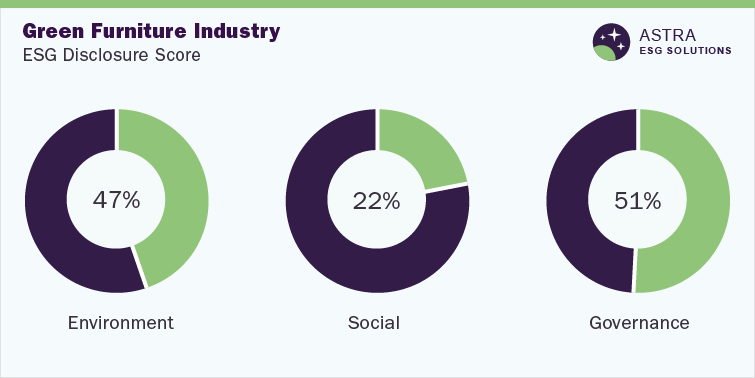
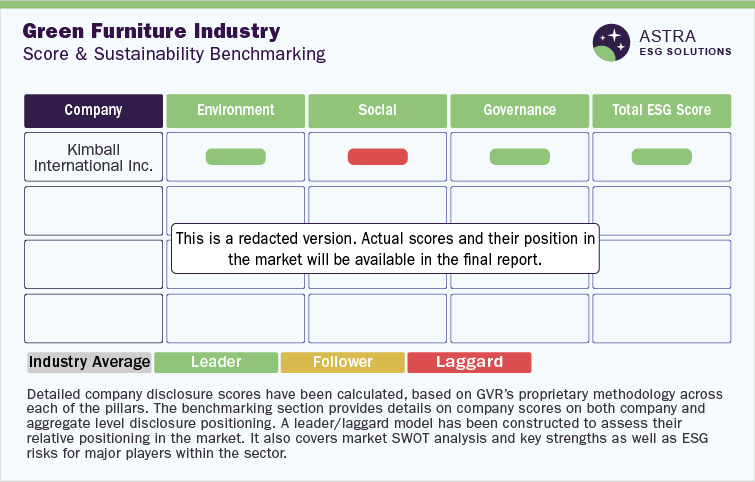
Environmental Insights
Green or sustainable furniture refers to furniture that is designed, produced, and used in a way that is environmentally and socially sustainable. It is based on the core values of using renewable raw materials & harmless substances, durability, fair production, and short transport routes. This includes furniture made from sustainable materials, such as bamboo, reclaimed wood, or recycled plastic; furniture that is energy-efficient; or furniture that is produced using sustainable manufacturing practices. It encompasses the entire life cycle of the product, from sourcing the materials to how it is used and eventually disposed of. Green furniture also takes into account the social impact of the production and use of the furniture, including fair labor practices, and it is designed to last longer and be easily repaired or repurposed.
According to our research, more than 80% of the profiled companies have disclosed data related to scope 1 and scope 2 GHG emissions, which is a strength for companies in this market showcasing their commitment to reduce carbon footprints and become carbon neutral in their operations.
Kimball International Inc., Williams-Sonoma, Inc., and La-Z-Boy Incorporated are three of the leading companies in the environmental pillar of this industry. Kimball reported the lowest scope 1 and scope 2 emissions for 2021 and has been able to achieve lower emissions by setting up emissions targets and executing energy-efficient projects. Companies in the industry have set emission reduction targets, increased their focus on using clean energy within their operations, and conducted regular energy assessments to decrease their overall energy consumption within their operations and reduce emissions.
More than 80% of the profiled companies in the industry have a waste management program as of 2021; however, less than 70% of these have set targets to reduce waste. Most of these firms focus on reducing packaging waste and diverting waste from landfills. Among the top three companies, all of them have waste-related targets, such as obtaining zero-waste certification for their facilities in their operations, which they aim to achieve by 2025. Nevertheless, only 50% of the firms profiled in our industry make efforts to disclose the percentage of waste recycled in their operations.
Despite making a positive environmental impact in certain areas, companies in this sector have large room for improvement in disclosing their water management programs and the amount of water recycled in their operations. Less than 20% of the companies in the industry possess the ISO 14001 Environmental Management Certification and only one company conducts environmental scenario analysis in compliance with the Paris Agreement.
With respect to environmental benchmarking, the following chart compares the Scope 1 and Scope 2 emissions along with the emission intensity of the top three companies in this category:-
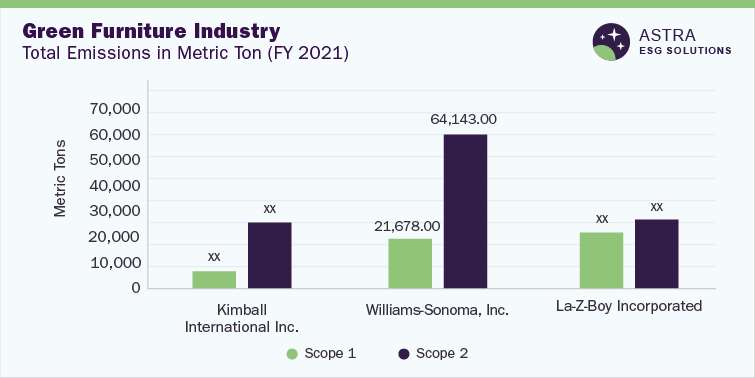
Social Insights
Different parameters, such as health and safety metrics, supply chain aspects, and local sourcing, can create a direct impact on the social sustainability of companies in the green furniture industry. Supply chain parameters mainly focus on human rights within the supply chain, which can be addressed through auditing policies. In terms of local sourcing, procuring raw materials locally creates employment within the local economy and helps reduce supply chain emissions. According to our research, all companies profiled in the green furniture market have a large scope for improvement in disclosing their social performance as they severely lag in the overall social disclosure in comparison to the environmental and governance disclosure.
In terms of positive impact, around 90% of the companies analyzed in our research have made disclosures on Diversity & Inclusion. Of the top three companies of the social pillar, which include Kimball International Inc., La-Z-Boy Inc., and IKEA Group, only IKEA Group has diversity targets in place, where it aims to increase ethnic, racial, and national diversity at key leadership levels by 2024. Similarly, more than 80% of the companies in this industry provide healthcare benefits to the employees and among the top three companies, Kimbal and La-Z-Boy provide dental insurance, pharmacy assistance, vision care, and many other health-related benefits alongside mental wellbeing benefits for its employees.
The companies in this market have room for improvement across several social parameters, including disclosure around work-life balance, product labeling and marketing, local sourcing, and health and safety indicators. According to our research, less than 20% of the companies in the industry have disclosures regarding the above. Out of the top three companies, only La-Z-Boy has reported its injury rate for the year 2021, which is a crucial health and safety metric. Similarly, in terms of the turnover rate in the organization, only Kimball has reported the total turnover rate for the year 2021 out of the top three firms. A turnover rate is an indicator of how well a company manages its human resources.
Governance Insights
ESG compliance in the green furniture industry is a crucial aspect of governance. According to our research, leading companies have pushed for codes of conduct, board diversity, board term limits, and director independence. All the profiled companies are reported to have a code of conduct policy in place that outlines the ethics and business conduct of employees while performing their duties. For instance, Williams Sonoma has an externally disclosed code of conduct that is applicable to all its directors and officers, among others.
In terms of board diversity, all six companies hold a diverse board with a 30% average representation of women across the boards. However, of the top three companies of the governance pillar, Williams Sonoma had the highest female percentage on its board of directors’ team, whereas RH (formerly known as Restoration Hardware Holdings, Inc.) had the lowest for the year 2021. A diverse board assists a company in an unbiased decision-making process and promotes organizational sustainability.
Furthermore, all companies in the green furniture industry showcase good governance practices, with 90% of the firms in the industry having more than 50% independent directors on board. They also have a term limit for directors. However, in terms of business preparedness, less than 20% of the firms have a Business Continuity Plan in place and only one firm has appointed a board to oversee cybersecurity initiatives, which are areas for improvement.
With respect to the governance benchmarking, the below charts compare the percentage of independent directors on board and the percentage of women on board across the three companies in this category:-
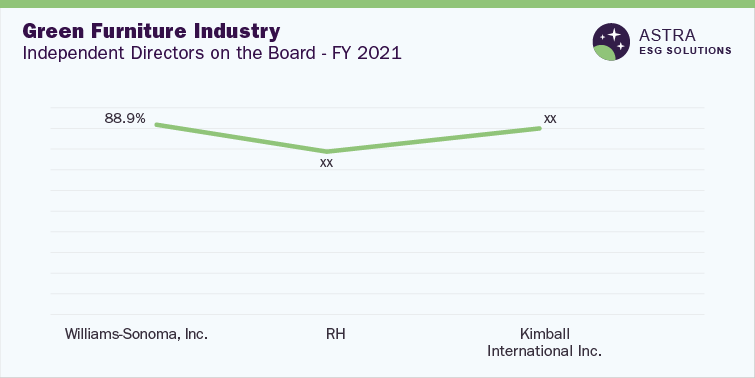
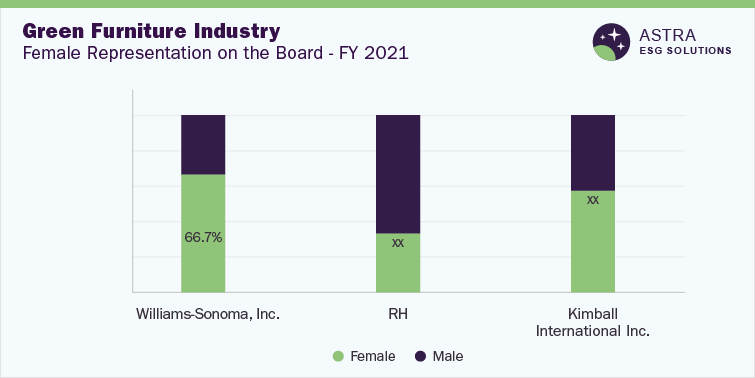
Country level Insights
China, Poland, and Germany are among the top countries in this green furniture market. In order to meet carbon neutrality goals, Chinese manufacturers have started manufacturing rattan, plant-based furniture, which produces more material within a short time. Various companies have taken a non-formaldehyde approach to manufacturing furniture and abstain from the use of toxic chemicals in manufacturing them. On the other hand, Polish furniture is considered durable and value for money; it exports furniture to Europe, majorly to Germany and the Czech Republic, and to other major countries across the globe. Tylko, a Poland-based furniture start-up, manufactures furniture from responsibly sourced materials, makes customized sustainable furniture with long life, and exports the same across Europe.
Italian furniture is known for comfort, versatility, and durability, which are some of the factors that make the market unique. In Italy, some of the furniture manufacturers use recycled material for manufacturing the products. For instance, Design Italy, which makes sustainable furniture, use recyclable or recycled materials to manufacture furniture, while Living Italian Luxury, another furniture producer, makes furniture from recycled materials and designs the products to be recycled again or compostable at the end-life stage.
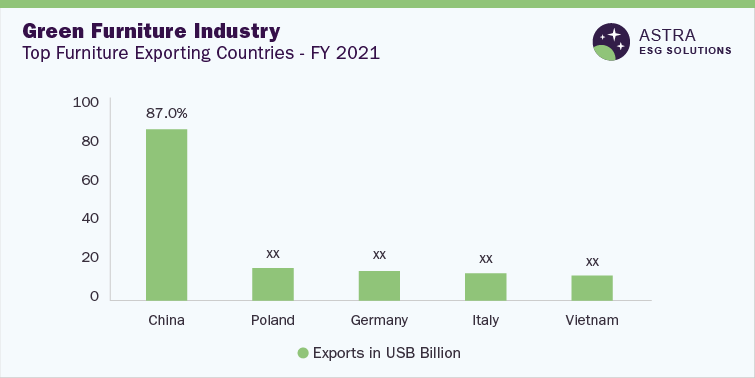
Market Overview
According to Grand View Research, the global eco-friendly furniture market has generated a revenue of USD 43.26 billion in 2022 and is forecast to expand with a Compound Annual Growth Rate (CAGR) of 8.6% from 2022 to 2030. An increase in consumer awareness about sustainability and the inclusion of sustainable raw materials in the manufacturing of furniture, coupled with higher spending capacities and improved infrastructure facilities, are reported to drive the green furniture market at a global scale.


